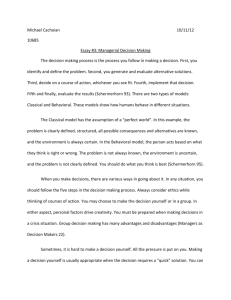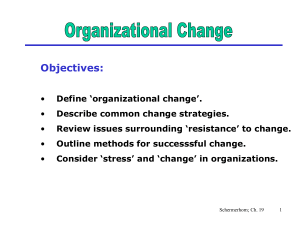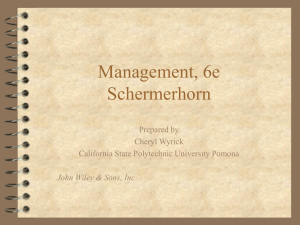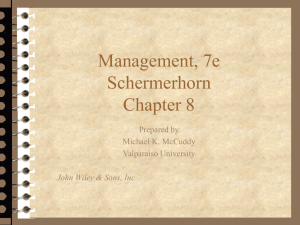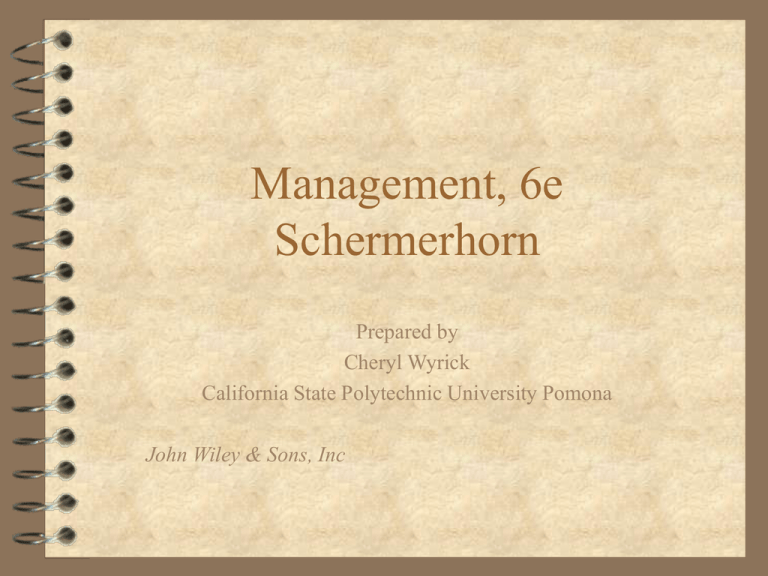
Management, 6e
Schermerhorn
Prepared by
Cheryl Wyrick
California State Polytechnic University Pomona
John Wiley & Sons, Inc
COPYRIGHT
Copyright 1999 © John Wiley & Sons, Inc. All rights reserved.
Reproduction or translation of this work beyond that named in
Section 117 of the United States Copyright Act without the express
written consent of the copyright owner is unlawful. Request for
further information should be addressed to the Permission
Department, John Wiley & Sons, Inc. The purchaser may make
back-up copies for his/her owner use only and not for distribution or
resale. The Publisher assumes no responsibility for errors,
omissions, or damages, cause by the use of these programs or from
the use of the information contained herein.
Chapter 13
Leading -- to Inspire Effort
Planning Ahead
–
–
–
–
What is leadership?
How do leaders gain and use power?
What are the important leadership traits and behaviors?
What can be learned from contingency theories of
leadership?
– What are current trends in leadership development?
Schermerhorn - Chapter 13
3
The Nature of Leadership
Leadership and Vision
– Leadership
• process of inspiring others to work hard to
accomplish important tasks
– Vision
• someone who has a clear sense of the future
Schermerhorn - Chapter 13
4
The Nature of Leadership
Leadership and Power
– Power
• ability to get someone
else to do what you
want them to do
Schermerhorn - Chapter 13
5
The Nature of Leadership
Sources of Position
Power
– Reward
• influence through rewards
– Coercive
• influence through
punishment
– Legitimate
• influence through authority
Schermerhorn - Chapter 13
6
The Nature of Leadership
Sources of Personal
Power
– Expert
• influence through
special expertise
– Referent
• influence through
identification
Schermerhorn - Chapter 13
7
The Nature of Leadership
Turning Power Into Influence
– centrality
– criticality
– visibility
Schermerhorn - Chapter 13
8
The Nature of Leadership
Turning Power Into Influence
– position, power, and interpersonal skills
•
•
•
•
no substitute for expertise
likable personal qualities are very important
effort and hard work breed respect
personal behavior must support expressed values
Schermerhorn - Chapter 13
9
•The Nature of Leadership
Acceptance Theory of Power
– the other person must
• understand the directive
• feel capable of carrying out the directive
• feel the directive is in the organization’s best
interests
• believe the directive is consistent with personal
values
Schermerhorn - Chapter 13
10
The Nature of Leadership
Leadership and Empowerment
– benefits
•
•
•
•
allows people to act independently
manager gains power
creates positive relationships
builds reference power
Schermerhorn - Chapter 13
11
Leadership Traits and Behaviors
Search for Leadership Traits
–
–
–
–
–
–
–
drive
desire to lead
motivation
honesty and integrity
self-confidence
intelligence and knowledge
flexibility
Schermerhorn - Chapter 13
12
Leadership Traits and Behaviors
Focus on Leadership
Behaviors
– Task and People Concerns
• task concern
– plans and defines work to be
done
– assigns task responsibilities
– sets clear work standards
– urges task completion
– monitors results
Schermerhorn - Chapter 13
13
•Leadership Traits and Behaviors
Focus on Leadership
Behaviors
– Task and People Concerns
• people concern
– acts warm and supportive
– develops social rapport
with them
– respects their feelings
– sensitive to their needs
– shows trust in them
Schermerhorn - Chapter 13
14
•Leadership Traits and Behaviors
Focus on Leadership Behaviors
– Styles
•
•
•
•
abdicative or laissez-faire
directive or autocratic
supportive or human relations
participative or democratic
Schermerhorn - Chapter 13
15
Contingency Approaches to
Leadership
Fiedler’s Contingency
Model
– good leadership
depends on a match
between leadership and
situational demands
• least-preferred
coworker scale (LPC)
Schermerhorn - Chapter 13
16
Contingency Approaches to
Leadership
Fiedler’s Contingency Model
– Diagnosing situational control
• leader-member relations (good or poor)
• degree of task structure (high or low)
• amount of position (strong or weak)
Schermerhorn - Chapter 13
17
Contingency Approaches to
Leadership
Fiedler’s Contingency Model
– Matching leadership style and situation
• task oriented leader is most successful
– very favorable (high control)
– very unfavorable (low control)
• relationship oriented leader is most successful
– moderate control situation
Schermerhorn - Chapter 13
18
Contingency Approaches to
Leadership
Hersey-Blanchard Situational Leadership
Model
– Leaders adjust their styles depending on the
readiness of their followers
• readiness
– how able, willing, and confident followers are to perform
tasks
Schermerhorn - Chapter 13
19
Contingency Approaches to
Leadership
Hersey-Blanchard Leadership Styles
– Delegating
– Participating
– Selling
– Telling
Schermerhorn - Chapter 13
20
Developments in Organization
Structures
Network Structures
– central core that is linked through networks of
relationships with outside suppliers of essential
services
• boundaryless organizations
• virtual corporations
Schermerhorn - Chapter 13
21
Contingency Approaches to
Leadership
Matching Hersey-Blanchard Leadership
Styles to Follower Readiness
–
–
–
–
Delegating = high readiness
Participating = moderate to high readiness
Selling = low to moderate readiness
Telling = low readiness
Schermerhorn - Chapter 13
22
Contingency Approaches to
Leadership
House’s Path-Goal Leadership Theory
– directive
– supportive
– achievement-oriented
– participative
Schermerhorn - Chapter 13
23
Contingency Approaches to
Leadership
Substitutes for Leadership
– Subordinate characteristics
– Task characteristics
– Organizational characteristics
Schermerhorn - Chapter 13
24
Contingency Approaches to
Leadership
Vroom-Jago Leader-
Participation Theory
– Choosing the best decisionmaking method
• authority
• consultative
• group
Schermerhorn - Chapter 13
25
Contingency Approaches to
Leadership
Vroom-Jago Leader-
Participation Theory
– Effective Leadership
• know when each
decision method is best
• be able to implement
well
Schermerhorn - Chapter 13
26
Contingency Approaches to
Leadership
Vroom-Jago Leader-Participation Theory
– Use group-oriented decision-making when
•
•
•
•
leaders lack sufficient information
problem is unclear
acceptance of decision by others is important
adequate time is available
Schermerhorn - Chapter 13
27
Contingency Approaches to
Leadership
Vroom-Jago Leader-Participation Theory
– Use authority-oriented decision-making when
•
•
•
•
leaders have expertise to solve problem
leader is confident and capable of acting alone
others are likely to accept the decision
little or no time available for discussion
Schermerhorn - Chapter 13
28
Trends in Leadership
Development
What is
Transformational
Leadership?
– Use of charisma and
related qualities to
raise aspirations and
shift people and
organizational systems
into new highperformance patterns
Schermerhorn - Chapter 13
29
Trends in Leadership
Development
Transactional
Leadership
– Use of tasks, rewards
and structures to help
followers meet their
needs while working to
accomplish
organizational
objectives
Schermerhorn - Chapter 13
30
Trends in Leadership
Development
Qualities of Transformational Leaders
– vision
– charisma
– symbolism
– empowerment
– intellectual stimulation
– integrity
Schermerhorn - Chapter 13
31
Trends in Leadership
Development
Gender and
Leadership
– Women may be more
prone to democratic
and participative
behaviors
– Men may be more
transactional
Schermerhorn - Chapter 13
32
Trends in Leadership
Development
“Good Old-Fashioned” Leadership
– define and establish a sense of mission
– accept leadership as responsibility rather than
rank
– earn and keep trust of others
Schermerhorn - Chapter 13
33
Trends in Leadership
Development
Ethical Aspects of Leadership
– responsibility to set high ethical standards
– obligation to supply necessary spark to awaken
potential
– high expectations tend to generate high
performance
Schermerhorn - Chapter 13
34

